Salem Country Club
MA, USA
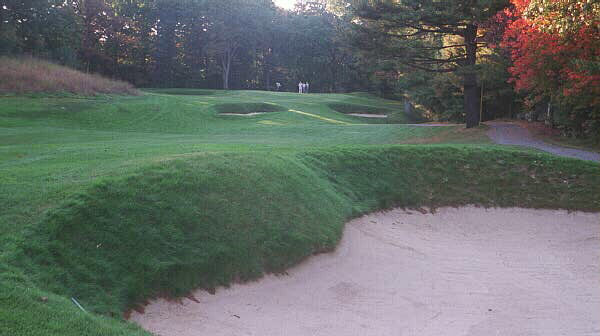
The rugged New England terrain makes Salem a Ross standout. Pictured is the all-world 13th hole.
The US Senior Open will be contested at Salem County Club in July, 2001. Much will be made of the ideal rolling New England terrain and the wonderful set of greens. Everyone will marvel at how Donald Ross created a perfect members course to play weekly and yet challenging enough forsome of the finest golfers in the world.
Forsuch reasons, Salem Country Club deservesits place in the spotlight of American golf. Built in 1925, Ross was at the height of his powers. From 1919 to 1925, five of the seven National Opens were contested on Ross courses. Donald J. Ross Associates, Inc. employed 3,000 (!) people at the time and his services were never in more demand.
Given such popularity, and with so many simultaneous projects going on, one would suspect some deterioration in the quality of his work, even amongst his finer projects. Certainly, such has occured in modern architecture when the biggest ‘name’ architects became swamped with work. Any originality was lost as they hurried from project to project and the quality of their work suffered, especially as it related to the detail work around the green complexes.
Salem, though, was always going to be different. Ross had the choice of 350 acres of rolling New England land from which to build a course. A master of routing a course and selecting the finest natural green sites, Salem appeared as a dream project for Ross.
Consequently,he spent an inordinate amount of time drawing each hole. A full set of hole diagrams exist to this day and they may well be his most intricate and complex. For instance, he painstakingly detailed how the thirteenth green complex should be designed. The result of such precise efforts? Well, in the case of the thirteenth green, he later called it ‘the finest green I ever designed.’
Indeed, this attention to detail resulted in a superior set of greens, even amongst Ross’s finest courses. There is not a single dull one and they range from the alarmingly excellent 13th green to greens like the 7th and 15th that are high on each side and funnel toward the middle to greens like the 4th, 9th, 10th, 12th, 17th, and 18th with their fearsome back to front pitch. In between such greens, there are some original green contours to be foundlike at the 16th with its distinctive moundson either side of the green.
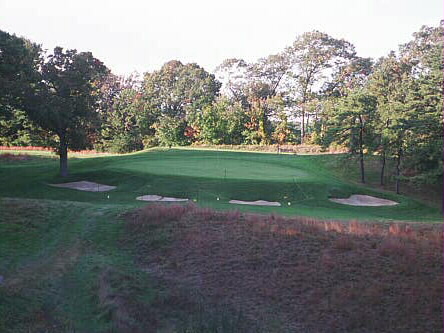
The par three 12th green features a fearsome amount of back to front slope, as is evident from the picture above.
In terms of how the greens affect strategy, it should be noted that half of them are as wide as theyare deep. Some like the eighth play even smaller as it slopes toward the back past the midway point. Others like the inverted saucer seventeenth green mean death to anyone who goes over. In either case, distant judgement from the fairway is at a premium at Salem.
Another factor that helped Ross was that no matter how busy his firm was, they could only move but so fast. After all, at the time, construction was done by horse and slip scrapers and sometimes tractors. Therefore, many of nature’s little humps and bumps remain throughout the fairways to this day. The golfer is always tweeking this and that in his set up, and thus Salem affords the opportunity for the better player to demonstrate his control over a varietyof situations. Modern architecture strips too much character from the land, and one walk around Salem makes any golfer lament the introduction of the bulldozer to golf course construction.
Some coursesgain a reputationbyeither theirambience and/or the fact that a big name architect designed it. Salem has both factorsin its favor but it deserves recognition for the most important reason of all: the high quality of its individual holes. Hole after hole offers something and Ross considered it ‘one of my purest designs.’ When strung together in such an uninterrupted setting of beauty, Frank Hannigan’s long time love affair with Salem becomes understandable.
Holes to Note
First hole, 410 yards; The perfect opener with everythinglaid before the golfer from the elevated tee.Imagine playing the hole back in the 1920s and 30s. After a fine drive, you have a long iron left that must fit in between a pair of bunkers that are cut into an upslope some 100 yards short of the green. You clip the ball just perfectly and it lands thirty yards short of the bunkerless green and rolls on. Two careful putts and away you go with the day’s first four. The hole remains an equal delight to this day to play, and just as challenging. Common with most of the holes at Salem, it enjoys an isolated nature.

Considered one of the finest opening holes in the country, the approach to the 1st.
Second hole, 395 yards; An appealing dogleg to the left, the ideal drive must carry a bunker on the inside of the dogleg at the 200 yard mark from the tee. Somewhat similarto the 1st hole, there is a step in the fairway, and depth perception for the approach becomes tricky. The two-tiered green is only 25 yards deep and an approach slightly long will roll off the back shaved bank and into a tightly mown chipping area. From there, you can readily tell just how good your opponent is based on how he handles this twitchy little chip – will he putt it, or hit the three wood chip so popular these days, or elect for a bump and run, or maybe even go with a lob wedge?
Third hole, 165 yards; A picture perfect one shotter to the firmest green on the course. Bunkered left and right with a fall off behind, nothing but a well struckiron will do.
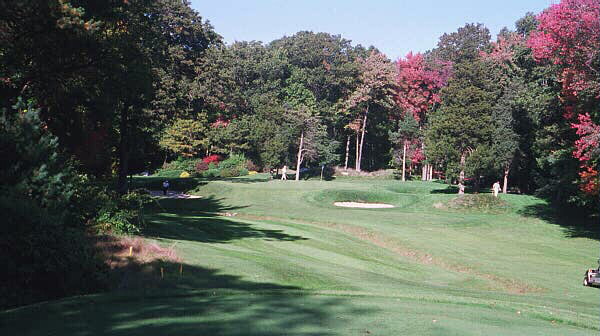
Ross believed that each one shot hole should be well defended and difficult: the set of one shotters at Salem live up to that charge. Pictured is the postcard 3rd hole.
Fourth hole, 400 yards; A fine compliment to the second hole, this dogleg swings right and the fairway is canted from left to right. A fade will catch the slope andbounddownhill toward the green. An easy hole to visualize today but remember: when Ross saw the land, it was completely covered in dense trees. Just to find this slope was an accomplishment and then to incorporate it so well into the playing strategyis aprime example of an architect maximizing the land.
Seventh hole, 390 yards; A good example of how Ross teamed with his experienced Massachusetts construction crew to yield a superior product. Ross had an uncanny ability to find ideal green locations on top of hills and hummocks and his instincts served him well here. However, what makes the hole exceptionalis the imaginative green contours. Aenaes Ross, Donald’s younger brother, was the construction foreman and he insured that his brother’s detailed drawings for this green were exactly carried out.The result is the largest green on the course at 7,700 square feet witha mound on the back right and a mound on the left that feed the ball in toward the lower, middle part of the green. The green makes the hole much more than just an uphill slog.
Eighth hole, 515 yards; This hole highlights Salem’s ultimate trump card: its terrain. A ridge separates the tee from the fairway in the valley below while a twenty foot tall chocolate drop mound pinches in 100 yards from the green. This long hole only required three bunkers and indeed Salem has a total of 56 bunkers, which is a relatively small number compared to the 108 at Scioto or the 87 at Oak Hill. However, it speaks volumes about the New England terrain and how Ross used it. Indeed, the left side of the 8th green complex makes for a fine study in the lost art of non-bunkering – Ross created a very interesting ledge effect by not using any bunkers and in the process, he made an up and down less likely.
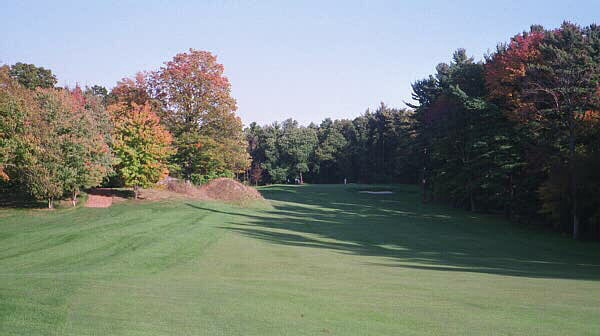
Note the chocolate drop mound on the left.
Ninth hole, 425 yards; A hole that was clearly not built in modern times. First, the fairway features all sorts of bumps and humps, particularly down the left hand side. Secondly, the pond doesn’t front the green but rather is 40 yards shy. Out of play, you say? Tell that to Ben Hogan who unsuccessfully tried to carry it from the left rough. Another feature of the hole is Ross’s clever use of misdirection: a straightdrive aimed toward the green will see the golfer’s ball end in the left rough (now known as Hogan’s Alley), thanks to the right to fairway’s left pitch. The golfer must force himself to aim further right than makes him comfortable but a relatively flat lie for his approach will be his reward if he does so.

Note the fairway humps and bumps and that the pond is well back from the men on the green.
Twelfth hole, 150 yards; A fine example of the attention to detail that the Club board places on presenting the course in as pure a Ross state as possible. A 1928 aerial photo showed only two front bunkers, and yet in 1994 the hole had four such bunkers. Figuring that two bunkers had erroneously been added, the Club removed them. Then, signed Ross plans came to light that showed he had in fact added the two bunkers in 1931. Armed with this new information, the Club authorized for the pair of bunkers to be restored. Top flight work was carried out in the summer of 2000 and once again four bunkers guard this severely pitched back to front green. A complete delight.
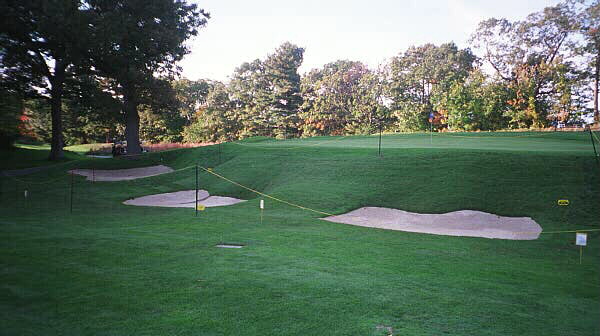
The newly restored bunkers that front the 12th green.
Thirteenth hole, 340 yards; Ross is credited with 413 courses by one count and that equates to 7,434 holes. Out of those holes, this one issurely in his top five. The drive is highly appealing into the bowl shaped fairway but the show stealer is the amazing green, one of Ben Crenshaw’s favorites in the world.

The view from the 13th tee is inspiring but…
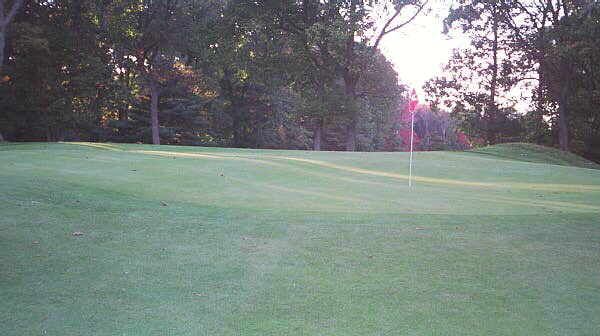
…the green is even better. Even with a setting sun, the front bowl which affords the only easy hole location is evident. The green slopes away to the left… and right… and behind!
Fourteenth hole, 215 yards; Studying how this green seems completely glued to the ground should be mandatory for any architect. Two bunkers are well short of each side of thegreen by some fifteen and ten yards respectively and often deceive the golfer into coming up short.
Fifteenth hole, 530 yards; The longest of the three shot holes at Salem, how the best senior players play it will be fascinating to watch. The tee ball is downhill to a fairway that slopes from right to left and sets up perfectly for a draw. However, at the 300 yard mark a brook in the left and right rough pinches the fairway to just twenty yards in width. The green is easily within reach from this area, which is the sole flat spot in the fairway. For those unwilling to accept the risk that the brook poses, they will have to lay back a touch. By doing so, they almost insure themselves of an awkward stance in the lumpy fairway and trying to reach the uphill green from such a position would be a mighty shot indeed. The green is funnel shaped with its high left and right sides that slope toward the middle.
Seventeenth hole, 425 yards; The last three holes at Salem are two shot holes of roughly the same length. Each is quite good and three golfers could reasonably choose any one of the three as his favorite. The authors select the 17th, thanks to its superlative green complex. The green is located on a small hillock and slopes from back to front and any shot out of the rough will not hold the shallow green. The resulting chip back can easily trundle across the green and off the falsefront. The only way to get a ball close to the front hole locations is to bump it into the bank that fronts the green.
The above should convey that Salem starts strong, finishes strong and some of the best holes are found in the middle section. What more can be said?! Ross was given 350 acres of rolling New England land from which to choose. He produced another brilliant routing and the holes flow with the terrain. His well trained construction crew then lavished attention on the green complexes,which Ross had carefully diagramed. No wonder the result is so strong.
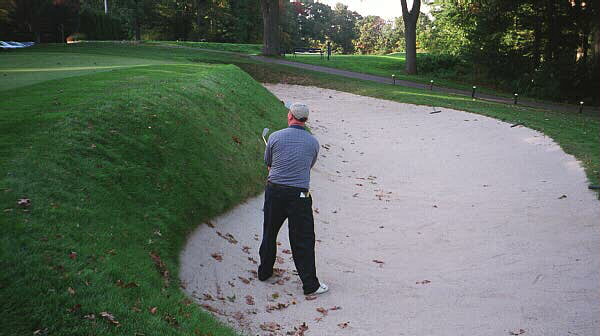
There are no weak holes at Salem. Even on the 500 yard three shot holes, bunkers like this one on the 11th will grab the careless golfer.
Ross succinctly states what constitutes the ideal course in Golf Has Never Failed Me:
‘The ideal course is one that presents a test of golf for the everyday golfer and the first-class player. A properly designed course can take care of every class of golfer. My aim is to bring out of the player the best golf in him. It will be difficult to negotiate some holes, but that is what golf is for. It is a mental test and an eye test. The hazards and bunkers are placed so as to force a man to use judgement and to exercise mental control in making the correct shot.’
There is no possible better description for Salem Country Club.
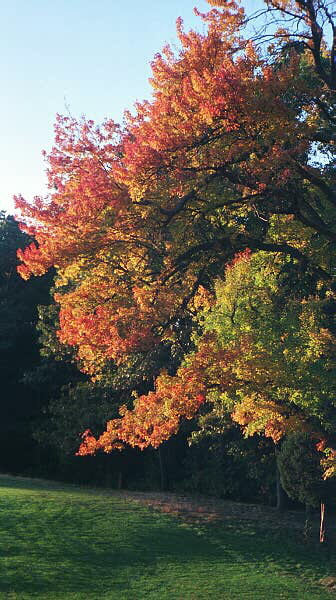
The specimen trees are perfect: they are both well back from play while still making autumnal golf special.
The End





![The Park, West Palm (Lit 9) [2023]](https://golfclubatlas.com/wp-content/uploads/2024/12/IMG_7092-2-scaled-500x383.jpg)


